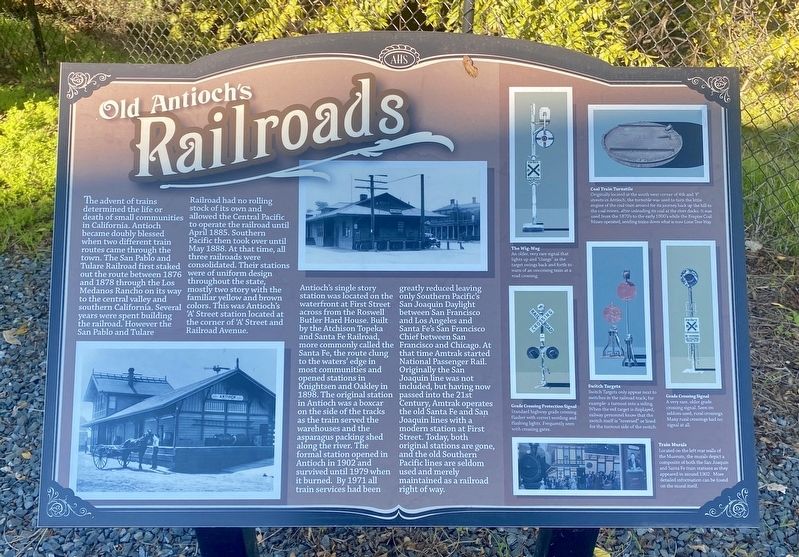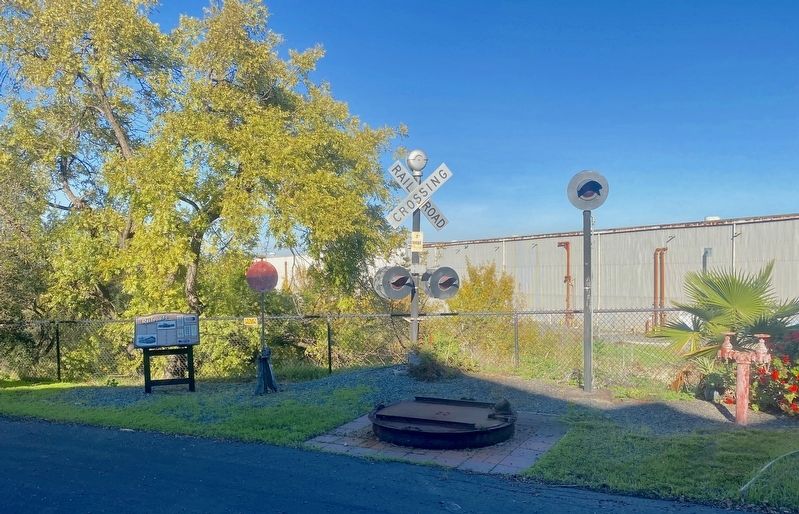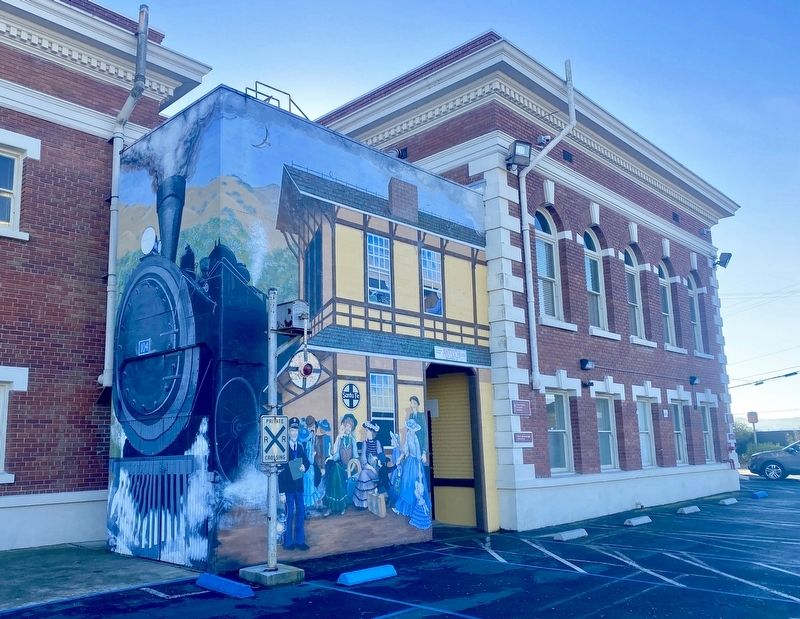Antioch in Contra Costa County, California — The American West (Pacific Coastal)
Old Antioch's Railroads
The advent of trains determined the life or death of small communities in California. Antioch became doubly blessed when two different train routes came through the town. The San Pablo and Tulare Railroad first staked out the route between 1876 and 1878 through the Los Medanos Rancho on its way to the central valley and southern California. Several years were spent building the railroad. However the San Pablo and Tulare Railroad had no rolling stock of its own and allowed the Central Pacific to operate the railroad until April 1885. Southern Pacific then took over until May 1888. At that time, all three railroads were consolidated. Their stations were of uniform design throughout the state, mostly two story with the familiar yellow and brown colors. This was Antioch's A' Street station located at the corner of W Street and Railroad Avenue.
Antioch's single story station was located on the waterfront at First Street across from the Roswell Butler Hard House. Built by the Atchison Topeka and Santa Fe Railroad, more commonly called the Santa Fe, the route clung to the waters' edge in most communities and opened stations in Knightsen and Oakley in 1898. The original station in Antioch was a boxcar on the side of the tracks as the train served the warehouses and the asparagus packing shed along the river. The formal station opened in Antioch in 1902 and survived until 1979 when it burned. By 1971 all train services had been greatly reduced leaving only Southern Pacific's San Joaquin Daylight between San Francisco and Los Angeles and Santa Fe's San Francisco Chief between San Francisco and Chicago. At that time Amtrak started National Passenger Rail. Originally the San Joaquin line was not included, but having now passed into the 21st Century, Amtrak operates the old Santa Fe and San Joaquin lines with a modern station at First Street. Today, both original stations are gone, and the old Southern Pacific lines are seldom used and merely maintained as a railroad right of way.
(Photo captions:)
The Wig-Wag An older, very rare signal that lights up and "clangs" as the target swings back and forth to warn of an oncoming train at a road crossing.
Coal Train Turnstile Originally located at the south west corner of 4th and 'F' streets in Antioch, the turnstile was used to turn the little engine of the coal train around for its journey back up the hill to the coal mines, after unloading its coal at the river docks. It was used from the 1870's to the early 1900's while the Empire Coal Mines operated, sending trains down what is naw Lone Tree Way.
Grade Crossing Protection Signal Standard highway grade crossing flasher with correct
wording and flashing lights. Frequently seen with crossing gates.
Switch Targets Switch Targets only appear next to switches in the railroad track; for example, a turnout into a siding. When the red target is displayed, railway personnel know that the switch itself is "reversed" or lined for the turnout side of the switch.
Grade Crossing Signal A very rare, older grade crossing signal. Seen on seldom used, rural crossings. Many rural crossings had no signal at all.
Train Murals Located on the left rear walls of the Museum, the murals depict a composite of both the San Joaquin and Santa Fe train stations as they appeared in around 1902. More detailed information can be found on the mural itself.
Erected by Antioch Historical Society.
Topics. This historical marker is listed in this topic list: Railroads & Streetcars.
Location. 38° 0.996′ N, 121° 49.581′ W. Marker is in Antioch, California, in Contra Costa County. Marker can be reached from West 4th Street. Touch for map. Marker is at or near this postal address: 1500 West 4th Street, Antioch CA 94509, United States of America. Touch for directions.
Other nearby markers. At least 8 other markers are within walking distance of this marker. The McCoy Cook House (within shouting distance of this marker); Antioch High School Cupola (within shouting distance of this marker);
Riverview Union High School (within shouting distance of this marker); Antioch Fibreboard Company (approx. 0.3 miles away); City of Antioch War Dog Memorial (approx. 0.4 miles away); Contra Costa County World War I Memorial (approx. half a mile away); The Cannery Lady (approx. half a mile away); F & AM - Antioch-Brentwood Lodge #175 Building (approx. 0.7 miles away). Touch for a list and map of all markers in Antioch.
More about this marker. The marker is around towards the back of the Antioch Historical Society Museum.
Credits. This page was last revised on November 19, 2021. It was originally submitted on November 16, 2021, by Andrew Ruppenstein of Lamorinda, California. This page has been viewed 564 times since then and 90 times this year. Photos: 1. submitted on November 16, 2021, by Andrew Ruppenstein of Lamorinda, California. 2, 3. submitted on November 19, 2021, by Andrew Ruppenstein of Lamorinda, California.


